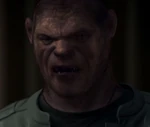Wesen (pronunciation: VAY-zin, Grimm: VES-sin; Germ. "a being", here "creature"; Spanish: espiritu bestia "spirit beast") is a collective term used to describe the creatures visible to the Grimms. They are the basis not only of the fairy tales that the Brothers Grimm have compiled, but also of the many legends and folklore from many cultures (i.e. Anubis, Aswang, Blutbad, Dämonfeuer, and Wendigo).
When a Wesen is woged, they are able to recognize a Grimm by looking into their eyes. According to Monroe, Wesen can see an "infinite darkness" in a Grimm's eyes that allows a Wesen to see their reflection, where they can see their true Wesen nature. ("Synchronicity")
History
Wesen are descended from an ancient set of Wesen races known as Pureblood Wesen. Purebloods exhibit traits which make them seem immortal and God-like compared to humans, and in ancient times many of them were worshipped as Gods and Goddesses. Today, however, Purebloods tend to try not to attract attention in an arguably more dangerous world and instead pull ropes on a quieter level than they once did. In doing so, they have generally lost their religious significance, becoming legends to Wesen and myths to Kehrseiten.(Issue 10)

A mummified Anubis
Wesen were once worshiped as Gods in Egypt hence why many Egyptian Gods such as Anubis, Bastet, Tefnut, Ammit, and Khepri are depicted with animal-like features. A few thousand years ago, thousands of slaves were tortured in search of Anubis and a few of them were successfully mummified fully woged. The Beati Paoli are a group of Wesen that formed in the 17th century who are fully against the display of deceased Wesen for the world to see and go after things such as museums, archaeological digs, antique auction houses, and sometimes private Wesen collectors if the collector is trafficking stolen Wesen antiquities. Most Wesen, including the Wesen Council, do not condone their methods, but they often have the same disapproving opinion of deceased Wesen being on display. ("Once We Were Gods")
During and before the Fourth Crusade, Wesen were used to fight in the armies of the Royal families, who used the Grimms to control and police their Wesen armies. Over the years, the Royal families either lost so much global power and influence that they could no longer use the Wesen as armies, or they had no need for Wesen soldiers and let the creatures spread across the world. ("Bad Teeth")
Over the centuries, carnivals have been known to house shows that force Wesen to fully woge for the act. These carnivals date back to Circus Maximus in Rome, but have since become much more uncommon. Despite knowingly showing Wesen in full woge to humans, they technically do not break the Gesetzbuch Ehrenkodex, due to the carnivals in question passing the Wesen off as magic tricks. ("The Show Must Go On")
Characteristics
To date, if there has been a study on Wesen origins, it has not surfaced. Even Sean Renard, who is a half-Zauberbiest of royal patronage, has not heard of any such study and the only studying he's aware of, done by Grimms, has been how to kill them. ("The Icy Touch") Wesen are liminal, that is, they display two states of existence simultaneous within one physical body. ("Happily Ever Aftermath") Physiologically, Wesen are parahuman, exhibiting two distinct sets of DNA within the same system. ("Big Feet") Albert Denswoz and his followers refer to themselves as Duo homo instead of Homo sapiens. Because some Wesen tend to de-humanize themselves in this manner, many treat humans as we would treat animals. ("The Icy Touch")
When in human form, Wesen are, by all accounts, physiologically that way and thus can pass as human. However, certain aspects about them still sets them apart from the rest of humanity, such as the addictive effects that Jay has upon them (which would otherwise be fatal for humans) and their susceptibility to the Yellow Plague. Every creature encountered by Nick Burkhardt are Wesen (excluding La Llorona and Volcanalis).
The community consists of both good and bad creatures ranging from Blutbaden to Bauerschwein to Mauvais Dentes. Individually, Wesen generally behave stereotypically in accordance to their own kind (i.e. the Blutbaden being fierce and vindictive, Siegbarste being dangerously vengeful, or Mellifers for their hive-like mentality and penchant for sending messages). Some Wesen follow ritualistic practices passed down through history (i.e. the Aseveracion and the Roh-hatz). Other than the Grimms, keeping the Wesen in check, only the Seven Houses are aware of the real workings of the world, the majority of humanity is blissfully unaware of their existence.
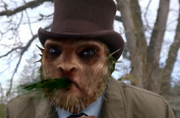
A Cracher-Mortel spitting tetradotoxin on a victim.
Ziegevolk, Musai, and Cracher-Mortel all have abilities that allow them to influence or have complete control over people. Ziegevolk use their pheromones to control and manipulate whoever they want, usually women. ("Lonelyhearts") ("One Angry Fuchsbau") Musai's lips secrete a psychotropic substance, making its kiss known to be very euphoric and addictive. After they kiss someone, they are able to easily manipulate their victims, who will do whatever they have to, to prove their love for the Musai, even kill someone or die themselves. ("Kiss of the Muse") Cracher-Mortel have the ability to create an army of zombie-like victims by spitting tetradotoxin on to the face of a victim, which seeps into the skin of the victim and shuts down the neurosignals of nerves and heart cells, and causes suspended animation. Atropine and scopolamine toxins reanimate the victim in a zombified state. In this state, the victim is in a trance and will perform whatever task is asked of them by the Cracher-Mortel. ("The Waking Dead") ("Goodnight, Sweet Grimm") ("The Ungrateful Dead")
Despite being parahuman themselves, many Wesen eat humans (ex: Blutbaden, Schakals, Wendigo, Coyotl, and Mauvais Dentes) or other Wesen (ex: Blutbaden eat Bauerschwein and Seelengut, while Lausenschlange eat Mauzhertz).
Some Wesen, like Raub-Kondors hunt other Wesen, such as Glühenvolk, for their skins. They use a potion called Sauver Sa Peau to keep them woged after death for up to 8 hours so they can skin them. ("Endangered")

The Hexenbiest spirit leaving Adalind's body.
In "Love Sick" Nick fights with Adalind and gets her to bite his lip causing him to bleed and some of the blood gets into her mouth. A few seconds later, the Hexenbiest spirit inside of Adalind leaves her body causing her to become a normal person, and lose all of her powers. So far this is the only time that a Wesen became a human and it's unknown if Grimm blood affects other Wesen types the same way. However, it is possible for the Hexenbiest to regain her powers if she gets pregnant and completes the Contaminatio Ritualis which results in the creation of a red paste that must be rubbed on the stomach of the Hexenbiest over the duration of the pregnancy. Once she gives birth, her powers and ability to woge return to her. ("The Ungrateful Dead") ("PTZD") ("Mommy Dearest")
It may also be possible to turn Wesen into normal humans via drugs. Konstantin Brinkerhoff pioneered a series of medicines that would supposedly remove the ability to woge. While the experiments were undoubtedly a failure, ("Big Feet") it must be pointed out that Brinkerhoff insisted that the drugs would work if he'd been given the time to perfect the dosage and delivery system. It was also unclear as to whether the drugs interfered with other Wesen abilities such as enhanced smell (Blutbaden) and increased bone density (Siegbarste).
Behavior
Some species such as Blutbaden and Fuchsbau will do an action called the Vertrautheiten (Germ. "familiarities") which is a way for two different species to start trusting each other more as being very close to another being is a special and sacred thing for Wesen. They let another Wesen get close enough to "memorize" their scent. To complete the action, the Wesen involved woge and then smell and rub up against each other on both sides of the other's face. ("Revelation")
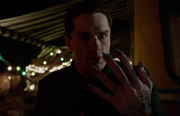
An Umkippen moment
If Wesen force their woge too many times and too often, their Wesen side can eventually start to take over, a situation known as the Umkippen (Germ. "tip," "upset"). If a Wesen is suffering from the Umkippen, their Wesen side could get out of control and completely eclipse any shred of humanity left if one does not go through some form of intervention. The suffering Wesen suffers blackouts and doesn't remember anything during the time that they lose control. ("The Show Must Go On")
Genetics
The complexity of Wesen genetics can be hard to understand, but Monroe and Rosalee explained a few things ("Stories We Tell Our Young"):
| Wesen | Kehrseite | Kehrseite-Genträger | |
|---|---|---|---|
| Wesen | 100% | 50% | 100% |
| Kehrseite | 50% | 0% | 0% |
| Kehrseite-Genträger | 100% | 0% | ? |
In a grundfalsch (fundamentally flawed) mixed-Wesen relationship, there is a Vorherrsch (prevalence)-- the offspring will be the "more dominant" Wesen type. There are health risks for the developing offspring, of course. ("Stories We Tell Our Young")
Hybrids
In some cases, genetics can get more complicated when it comes to hybrids. It is possible for the offspring of a human and a Wesen such as a Hexenbiest to not be able to woge fully and only have parts of their face and/or other body parts woge as with the case of Sean Renard. It is also possible for the DNA of one Wesen species to be spliced with the DNA of another while in utero which is what Dr. Higgins did with her son, Pierce. Doing so caused Pierce to experience something equivalent to a split personality disorder where the Löwen side would come out without him realizing it, and it would only do so to protect him or eliminate threats/competition from his life.
Wesen by Season
Note: This table does not include non-Wesen beings, comic Wesen, or unused Wesen.
Wesen Species
For the TV series, there have been a total of 79 Wesen species encountered, mentioned, or seen in a diary and 2 non-Wesen beings encountered. There have also been 17 other species seen or mentioned in the Grimm comics, 1 species in the novels, and 2 species that have never been seen or mentioned anywhere except for on the Season 1 DVD packaging and in Aunt Marie's Book of Lore.
Note: The Rißfleisch and the Waschbar are counted separately between the show and the comics as the Rißfleisch was only seen in a Grimm diary and the Waschbar was only mentioned on the show, but they both appeared in the comics.
Physically appeared Wesen
| Anubis | 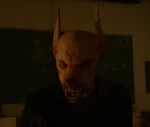
|
uh-NOO-biss (In Ancient Greek: Ἄνουβις "Anubis, Egyptian God of the cemetery") | Dog-like creature | "Once We Were Gods" |
| Aswang | 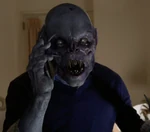
|
ah-SWAH-ng (In Tagalog: "monster") | Ghoul-like creature | "Mommy Dearest" |
| Balam | 
|
ɓaa-LAAM (In Yucatec: "jaguar") | Jaguar-like creature | "La Llorona" |
| Bauerschwein | 
|
BOW-ur-shvine (In German: Bauer "farmer" + Schwein "pig") | Pig-like creature | "The Three Bad Wolves" |
| Blutbad | 
|
BLOOT-baat (In German: Blut "blood" + Bad "bath") | Wolf-like creature | "Pilot" |
| Coyotl | 
|
koh-YOO-tuhl (In Nahuatl: "coyote") | Coyote-like creature | "Bad Moon Rising" |
| Cracher-Mortel | 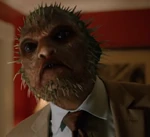
|
CRA-shay mor-TEL (In French: Cracher "to spit" + Mortel "deadly" or "mortal") | Puffer fish-like creature | "The Waking Dead" |
| Dämonfeuer | 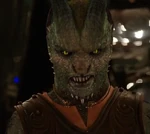
|
DAY-mon-foy-ər (In German: Dämon "demon" + Feuer "fire") | Dragon-like creature | "Plumed Serpent" |
| Dickfellig | 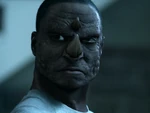
|
DIK-fay-likh (In German: "thick-skinned") | Rhinoceros-like creature | "Last Grimm Standing" |
| Drang-Zorn | 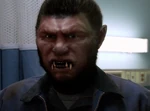
|
drahng-tsorn (In German: Drang "urge, stress" + Zorn "wrath") | Badger-like creature | "The Bottle Imp" |
| Eisbiber | 
|
ICE-bee-bur (In German: Eis "ice" + Biber "beaver") | Beaver-like creature | "Danse Macabre" |
| El Cucuy | 
|
el KOO-koo-ee (In Spanish: el Coco "the Bogeyman") | Vigilante-type creature | "El Cucuy" |
| Fuchsbau | 
|
FOOKS-bow (In German: "fox hole" or "burrow") | Fox-like creature | "Organ Grinder" |
| Fuchsteufelwild | 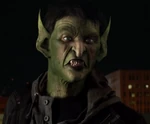
|
FOOKHS-toy-fuhl-vilt (In German: fuchsteufelswild "furious as a fox-devil") | Goblin-like creature | "Nameless" |
| Gedächtnis Esser | 
|
(In German: Gedächtnis "memory" + Esser "eater") | Octopus-like creature | "Thanks for the Memories" |
| Geier | 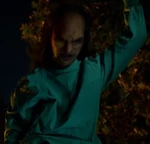
|
GY-ər (In German: "vulture") | Vulture-like creature | "Organ Grinder" |
| Gelumcaedus | 
|
GAY-loom-KY-dus (In Latin: Gelum "coldness" + Caedis "kill") | Alligator-like creature | "Cold Blooded" |
| Genio innocuo | 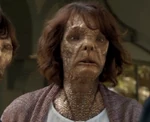
|
JEE-nee-oh in-NO-koo-oh (In Latin: Genio "genius" + Innocuo "harmless") | Tortoise-like creature | "The Other Side" |
| Glühenvolk | 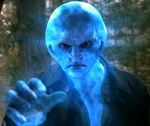
|
GLOO-in-folk (In German: Glühen "glow" + Volk "people") | Alien-like creature | "Endangered" |
| Hässlich | 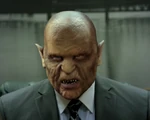
|
HAYS-likh (In German: "ugly, nasty") | Troll-like creature | "Pilot" |
| Hexenbiest (♀)
Zauberbiest (♂) |
HEK-sən-beest (In German: Hexe "witch" + Biest "beast")
TSOW-bər-beest (In German: Zauber "magic" or Zauberer "wizard" + Biest "beast") |
Witch-like creature | "Pilot" | |
| Höllentier | 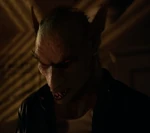
|
HØ-lehn-teer (In German: Hölle "hell" + Tier "animal") | Hellhound-like creature | "El Cucuy" |
| Hundjäger | 
|
HOONT-yay-gər; (In German: Hund "dog" + Jäger "hunter") | Hound dog-like creature | "Cat and Mouse" |
| Jägerbar | YAY-gər-bar (In German: Jäger "hunter" + Bär "bear") | Bear-like creature | "Bears Will Be Bears" | |
| Jinnamuru Xunte | 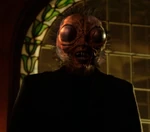
|
JIN-nuh-muh-ROO CHOON-tay (In Eastern Maninkakan: jinne "evil spirit" + muruxuntee "person with a limp") | Fly-like creature | "Mr. Sandman" |
| Klaustreich | 
|
KLOW-shtrykh (In German: klauen "steal" + Streich "prank/trick" or alternatively Klau(e) "claw" + Streich "stroke") | Alley cat-like creature | "The Thing with Feathers" |
| Königschlange | 
|
KOE-nig-shlaa-nguh (In German: König "king" + Schlange "snake") | King cobra-like creature | "Over My Dead Body" |
| Koschie | 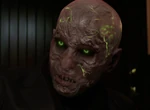
|
KAH-shee (In Russian: Коще́й "Koshchey") | Radioactive skeleton-like creature | "Red Menace" |
| Krampus | 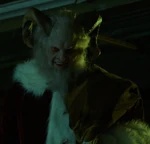
|
KRAAM-puus (In German: Krampen "claw") | Anti-Santa creature | "Twelve Days of Krampus" |
| Lausenschlange | 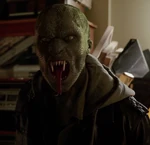
|
LOW-zin-shlo-nguh (In German: Laus "louse" + Schlange "snake") | Snake-like creature | "Of Mouse and Man" |
| Lebensauger | 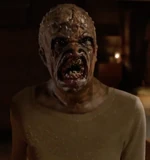
|
LAY-bən-zow-gər (In German: Leben "life" + sauger "sucker") | Leech-like creature | "The Hour of Death" |
| Löwen | LØ-vin (In German: "lion") | Lion-like creature | "Last Grimm Standing" | |
| Luisant-Pêcheur | 
|
lw-EE-zah pesh-UR (In French: Luisant "shiny" + Pêcheur "fisher") | Otter-like creature | "Kiss of the Muse" |
| Malin Fatal | 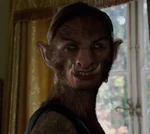
|
MAH-leh fə-TAL (In French: Malin "malicious" + Fatal "fatal") | Boar-like creature | "Red Menace" |
| Manticore | 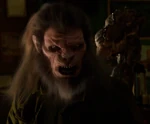
|
MAN-tə-kor (In English: Manticore; from Early Middle Persian: Martyaxwar "a legendary Arabian cryptid") | half lion, half scorpion-like creature | "The Good Soldier" |
| Mauvais Dentes | 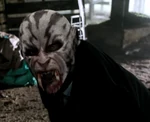
|
MO-vay don (In French: Mauvais "bad" + Dents "teeth") | Saber-toothed tiger-like creature | "Bad Teeth" |
| Mauzhertz | 
|
MOWTS-hairts (In German: Maus "mouse" + Herz "heart") | Mouse-like creature | "Of Mouse and Man" |
| Mellifer | 
|
MEL-ə-fər (In Latin: Mellis "honey" + Ferre "to bear") | Bee-like creature | "Beeware" |
| Murciélago | 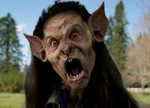
|
Mur·cié·la·go (In Spanish: "bat") | Bat-like creature | "Happily Ever Aftermath" |
| Musai | 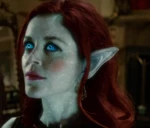
|
moo-ZY-ee (In Ancient Greek: Μοῦσαι "muses") | Muse-like creature | "Kiss of the Muse" |
| Naiad | NY-ad (In Middle English: ""water nymph"") | Mermaid-like creature | "One Night Stand" | |
| Nuckelavee | 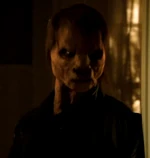
|
noo-keh-LAA-vee (In Scottish Gaelic: Nuckelavee) | Horse-like creature | "Quill" |
| Pflichttreue | 
|
PFLIKHT-troy-ə (In German: "one who is dutiful") | White panther-like creature | "Stories We Tell Our Young" |
| Raub-Kondor | 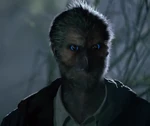
|
ROWB kohn-dorr (In German: Raub "robbery" + Kondor "condor") | Condor-like creature | "Endangered" |
| Reinigen | 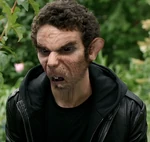
|
RY-ni-gin (In German: "to clean") | Rat-like creature | "Danse Macabre" |
| Schakal | 
|
SHAAK-aal (In German: "jackal") | Jackal-like creature | "Three Coins in a Fuchsbau" |
| Scharfblicke | 
|
SHAARF-blik-uh (In German: Scharf "sharp" + Blicke "sight", "look" or "view") | Owl-like creature | "Face Off" |
| Seelengut | 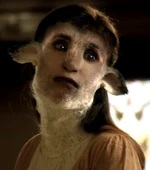
|
ZAY-luhn-goot (In German: "kindhearted") | Sheep-like creature | "The Good Shepherd" |
| Seltenvogel | 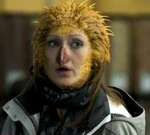
|
ZEL-tən-voh-gəl (In German: Selten "rare" + Vogel "bird") | Extremely rare bird-like creature | "The Thing with Feathers" |
| Siegbarste | 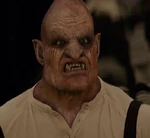
|
ZEEG-bars-tuh (In German: Sieg "victory" + Barst "burst, broken") | Ogre-like creature | "Game Ogre" |
| Skalengeck | 
|
SKAA-lən-gek (In German: Skalen "measuring scales" + Geck "fop") | Lizard-like creature | "Pilot" |
| Skalenzahne | 
|
SKAA-lin-tsaa-nuh (In German: Skalen "scales" + Zähne "teeth") | Crocodile-like creature | "Last Grimm Standing" |
| Spinnetod | 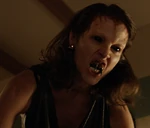
|
SHPIN-nuh-toht (In German: Spinne "spider" + Tod "death") | Spider-like creature | "Tarantella" |
| Stangebär | 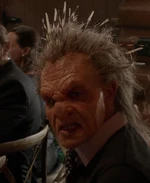
|
SHTAA-nguh-bair (In German: Stange "rod, spear" + Bär "bear") | Porcupine-like creature | "Quill" |
| Steinadler | 
|
STINE-ad-lur (In German: Stein "stone" + Adler "eagle") | Hawk-like creature | "Three Coins in a Fuchsbau" |
| Taureus-Armenta | 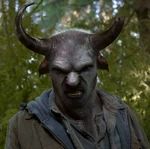
|
TAH-ree-oos arr-MIN-tuh (In Latin: Taureus "bull", "ox" + Armenta "cattle for ploughing") | Minotaur-like creature | "Volcanalis" |
| Wendigo | 
|
WIN-dee-go (In Algonquian: "evil spirit" or "cannibal") | Savage, human-like creature | "To Protect and Serve Man" |
| Wildermann | 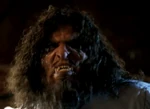
|
VIL-dər-maan (In German: Wilder "wild" + Mann "man") | Bigfoot-like creature | "Big Feet" |
| Wildesheer | 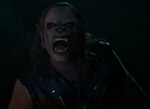
|
VIL-dəs-hair (In German: Wildes "wild" + Heer "army") | Wolf-like creature | "The Wild Hunt" |
| Yaguaraté | 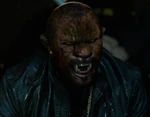
|
YAH-gwar-et-aye (In Spanish: Yaguareté "jaguar") | Jaguar-like creature | "Eyes of the Beholder" |
| Ziegevolk | 
|
TSEE-guh-folk (In German: Ziege "goat" + Volk "people") | Goat-like creature | "Lonelyhearts" |
Non-Wesen Beings
| La Llorona | 
|
lah yor-OH-nuh (In Spanish: "The Weeping Woman") | Ghost | "La Llorona" |
| Volcanalis | 
|
vohl-kuhn-AL-is (In Latin: "The Flamen of Vulcan") | Demon | "Volcanalis" |
Mentioned/Seen in Grimm Diaries only Wesen
| Abartige Aasfresser | 
|
AHB-ar-tih-guh AHSS-freh-suhr (In German: abartig "deviant" + Aasfresser "scavenger") | Hyena-like creature | "The Inheritance" |
| Abath | 
|
AH-bahth (In English: "female unicorn") | Unicorn-like creature | "Blond Ambition" |
| Ammit | 
|
AHM-mit (In Egyptian: "devourer of the dead") | Chimera-like creature | "Once We Were Gods" |
| Augapfel-Aushacken | OWK-ahp-fel-OWSS-hah-ken (In German: "to peck out the eyeball") | Bird-like creature | "Nobody Knows the Trubel I've Seen" | |
| Bastet | 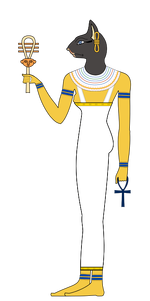
|
BAHS-t (In Egyptian: "she of the ointment jar") | Feliform-like creature | "Once We Were Gods" |
| Faeteo fatalis | 
|
FAY-tee-oh fə-TALL-is (In Latin: Faeteo "stinking" + Fatalis "deadly") | Skunk-like creature | "El Cucuy" |
| Fétide Taillader | FEH-tid TAH-yah-deh (In French: "fetid" + "to slash") | Unknown | "Nobody Knows the Trubel I've Seen" | |
| Gefrierengeber | gə-FREE-rən-guh-BAIR (In German: Gefrieren "to freeze, forming ice or frost" + Gebär "giver") | Unknown | "Let Your Hair Down" | |
| Khepri | 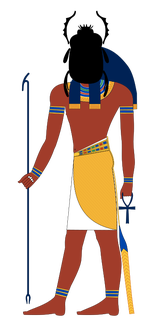
|
KHEP-ree (In Egyptian: "creator") | Beetle-like creature | "Once We Were Gods" |
| Mordstier | 
|
MORT-shteer (In German: Mord "murder" + Stier "bull") | Bull-like creature | "Game Ogre" |
| Rißfleisch | 
|
RISS-flysh (In German: Riss "tore, ripped" or Riss "the kill of a predator -> prey" + Fleisch "flesh, meat") | Tiger-like creature | "Game Ogre" |
| Rotznasig Carcaju | ROHTS-naa-zig kar-KAH-zhu (In German: Rotznasig "snot-nosed") + (In Portuguese: Carcaju "wolverine") | Wolverine-like creature | "Bad Teeth" | |
| Sangrienta Manos | sahn-gree-IN-tah MAH-nohss; (In Spanish: "bloody hands") | Unknown | "Nobody Knows the Trubel I've Seen" | |
| Schneetmacher | SHNAYT-maakh-ər (In German: Schnee "snow" and Schneien "to snow" + Macher "maker") | Unknown | "Tarantella" | |
| Shnabeltiermörder | 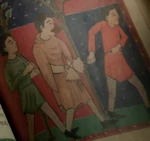
|
SHNA-bəl-teer-MØR-tər (In German: Schnabeltier "platypus" + Mörder "murderer") | Platypus-like creature | "The Good Soldier" |
| Tefnut | 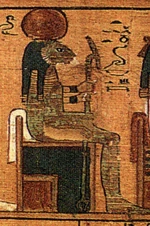
|
TEF-nut (In Egyptian: "that water") | Lion-like creature | "Once We Were Gods" |
| Trasque | 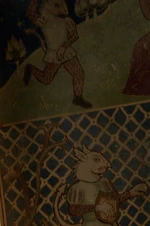
|
TRASK (In French: Tarasque "a legendary Galatian dragon") | Dragon-like creature | "The Good Soldier" |
| Waage | 
|
VAA-guh (In German: "[weighing] scales") | Unknown | "Pilot" |
| Waschbar | VAASH-bar (In German: "raccoon") | Raccoon-like creature | "Organ Grinder" |
Unused Wesen
These Wesen have never been seen or mentioned on the show, comics, novels, etc. but they were both listed on the Season 1 DVD packaging and in Aunt Marie's Book of Lore.
| Grauhund | GROW-hoont (In German: "greyhound") | Greyhound-like creature |
| Spokelseshorn | SPU-kil-suhss-horn (In New Norwegian: spøkelse "ghost" + horn "antler") | Skeletal elk-like creature |
Wesen Seen/Mentioned in Comics Only
| Name | Image | Pronunciation | Type | First Appearance |
|---|---|---|---|---|
| Frosch Schleimig | FROSH shly-mikh (In German: Frosch "frog" + Schleimig "slimy") | Frog-like creature | Issue 10 | |
| Hadosheru | 
|
HAA-doh-SHEH-roo (In Japanese: "hard shell") | Rhinoceros-beetle-like creature | Issue 9 |
| Hippos athanatos | 
|
HEEP-pohs ah-THAH-nah-tohs (In Ancient Greek: "deathless horse") | Horse-like creature | Issue 11 |
| Ichor-thanatos | 
|
EE-khor THAH-nah-tohs (In Ancient Greek: "death") | Hydra-like creature | Issue 11 |
| Kasipepo | 
|
KAA-see-PAY-poh (In Swahili: Kasi "speed" + Pepo "demon") | Cheetah-like creature | Issue 7 |
| Maahes | 
|
MAH-hees (In Ancient Egyptian: "he who is beside her") | Lion-like creature | Issue 10 |
| Minotaur | 
|
MIN-ə-ta(w)r (In English Minotaur; from Ancient Greece: Μινώταυρος "Minos's bull") | Bull-headed man-like creature | Issue 2 |
| Nilpferd | NILP-fairt (In German: "hippopotamus") | Hippopotamus-like creature | Issue 3 | |
| Rißfleisch | 
|
RISS-flysh (In German: Riss "tore, ripped" or Riss "the kill of a predator -> prey" + Fleisch "flesh, meat") | Tiger-like creature | Issue 12 |
| Sorglosgör | 
|
ZORG-lohs-gur (In German: Sorglos "carefree" + Gör "child") | Old child-like creature | Issue 6 |
| Unnamed Chinese Dragon-like Wesen | 
|
Chinese Dragon-like creature | Issue 10 | |
| Unnamed Dromaeosaur-like Wesen | 
|
Dromaeosaur-like creature | It's Portland, Wu Issue 1 | |
| Unnamed Griffin-like Wesen | 
|
Griffin-like creature | Issue 12 | |
| Unnamed Hare-like Wesen | 
|
Hare-like creature | It's Portland, Wu Issue 1 | |
| Unnamed Schnauzer-like Wesen | 
|
Schnauzer-like creature | It's Portland, Wu Issue 1 | |
| Unnamed Seal-like Wesen | 
|
Seal-like creature | Issue 12 | |
| Unnamed Weasel-like Wesen | 
|
Weasel-like creature | Issue 1 | |
| Unnamed Yoda-like Wesen | 
|
Yoda-like creature | Issue 12 | |
| Waschbar | 
|
VAASH-bar (In German: "raccoon") | Raccoon-like creature | Issue 1 |
| Wütende Taube | VOO-ten-də TOW-bə (In German: "angry pigeon") | Pigeon-like creature | Issue 8 |
Novel Wesen
| Wechselbalg | VEKH-sel-balkh (In German: "changeling") | Doppelgänger creature | The Killing Time |



